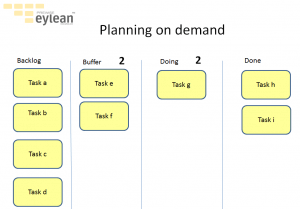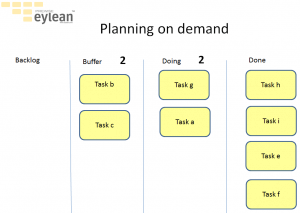Planning on demand is a method suited for fast paced production planning which has a dynamic, always changing environment. It is based on Scrumban methodology, which combines the flexibility of Kanban and the basic features of Scrum. The key principles of planning on demand are that you don’t plan too much, you control what is being done, your team is always occupied and a team is always aware of the situation.
Planning: The planning on demand term in itself says that a task is being worked on only when there is a demand for it. Whether it is an important task or a minor task, there will always be something that needs to be done. Those tasks that are in a backlog can be divided into priorities like tasks that are the most important to be done next and less important tasks. This gives a clear view of what the priorities are. It is also important to decouple planning and releasing, as planning on demand generally be focuses more on releasing than planning.
for it. Whether it is an important task or a minor task, there will always be something that needs to be done. Those tasks that are in a backlog can be divided into priorities like tasks that are the most important to be done next and less important tasks. This gives a clear view of what the priorities are. It is also important to decouple planning and releasing, as planning on demand generally be focuses more on releasing than planning.
 Control: Maintaining a control on what is being done is what every project manager should always take into consideration very carefully. If a team has to do more tasks than they can handle, the entire project becomes chaotic. Workers lose focus on their current tasks and start multitasking, which may be a time wasting approach. Therefore, it is a good idea to plan project small, where a single worker has to do one or two tasks at a time, depending on the capabilities of a team. However, sometimes multitasking is not avoidable, so it is a good idea to have some kind of metric which limits work in progress and allows some multitasking, while still keeping it under control.
Control: Maintaining a control on what is being done is what every project manager should always take into consideration very carefully. If a team has to do more tasks than they can handle, the entire project becomes chaotic. Workers lose focus on their current tasks and start multitasking, which may be a time wasting approach. Therefore, it is a good idea to plan project small, where a single worker has to do one or two tasks at a time, depending on the capabilities of a team. However, sometimes multitasking is not avoidable, so it is a good idea to have some kind of metric which limits work in progress and allows some multitasking, while still keeping it under control.
 Occupied team: A successful project always has its team members occupied, working on some task that is. In Scrumban a pull principle is used, where new tasks can be introduced, but you don’t assign them to anyone. Every team member assigns items to themselves and they decide what tasks they want to do, or are able to do, according to their specialization. Even when the backlog becomes empty, team members can assign tasks to themselves. This works well with planning on demand method, as the team does not need to waste time on planning.
Occupied team: A successful project always has its team members occupied, working on some task that is. In Scrumban a pull principle is used, where new tasks can be introduced, but you don’t assign them to anyone. Every team member assigns items to themselves and they decide what tasks they want to do, or are able to do, according to their specialization. Even when the backlog becomes empty, team members can assign tasks to themselves. This works well with planning on demand method, as the team does not need to waste time on planning.
Awareness: The small project planning approach and the limitations to tasks that can be done at a certain time helps the team understand their current objectives. Small project means having less items on the to do list at one time and new items only appear on that list when there is a demand for them. Limitations reduce the number of items both on the, to do and doing lists, thus making the overall project clearer. Of course, planning on demand can also work with larger projects, but team size needs to be taken into consideration. Bigger teams may impact how clear each individual understands their tasks.
Planning on demands works well with a simple board using a Kanban approach with sticky notes. It helps visualize the process and simplify the planning on demand method even more. However, many teams which use this method are distributed or there might be several or more teams working on one project. In this case, having software which visually presents and updates in real time may be a better option.
As for the meetings, Scrumban uses Kaizen. Usually, continuous improvement is not a necessity in Scrumban, Kaizen events, however, can be used for this purpose. How often should these meeting be made is entirely optional for each team. A good way to find an estimation, is to start doing Kaizen meeting after each iteration, and later a team can discover that these meeting should be done more often.
With the pull system in place, weaknesses and opportunities can be identified with flow diagrams for Kaizen meetings. As burndown charts show whether or not you are delivering value, but not much about why, average cycle time should become the primary focus of performance, which shows the cause. If cycle time is under control and the team capacity is balanced against demand, then lead time will also be under control. If cycle time is under control, then burndowns are predictable. By understanding lead and cycle times you will understand how long does it take for a task to reach the end consumer, how long does it take to develop it, as well as, how long does it stay in management and release.
On the whole, planning on demand uses the Scrumban approach, which offers a slightly more flexible process for fast paced production than the other methodologies. Planning on demand is not something that can be easily predicted, because of the dynamic environment therefore, it fits best for startups, fast paced projects and continuous product manufacturing.






